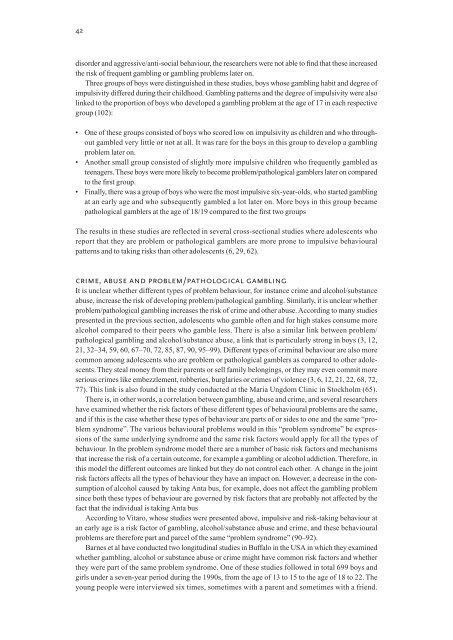Gambling Among Young People, 837 kB
Gambling Among Young People, 837 kB
Gambling Among Young People, 837 kB
You also want an ePaper? Increase the reach of your titles
YUMPU automatically turns print PDFs into web optimized ePapers that Google loves.
42<br />
disorder and aggressive/anti-social behaviour, the researchers were not able to find that these increased<br />
the risk of frequent gambling or gambling problems later on.<br />
Three groups of boys were distinguished in these studies, boys whose gambling habit and degree of<br />
impulsivity differed during their childhood. <strong>Gambling</strong> patterns and the degree of impulsivity were also<br />
linked to the proportion of boys who developed a gambling problem at the age of 17 in each respective<br />
group (102):<br />
• One of these groups consisted of boys who scored low on impulsivity as children and who throughout<br />
gambled very little or not at all. It was rare for the boys in this group to develop a gambling<br />
problem later on.<br />
• Another small group consisted of slightly more impulsive children who frequently gambled as<br />
teenagers. These boys were more likely to become problem/pathological gamblers later on compared<br />
to the first group.<br />
• Finally, there was a group of boys who were the most impulsive six-year-olds, who started gambling<br />
at an early age and who subsequently gambled a lot later on. More boys in this group became<br />
pathological gamblers at the age of 18/19 compared to the first two groups<br />
The results in these studies are reflected in several cross-sectional studies where adolescents who<br />
report that they are problem or pathological gamblers are more prone to impulsive behavioural<br />
patterns and to taking risks than other adolescents (6, 29, 62).<br />
crime, abuse and problem/pathological gambling<br />
It is unclear whether different types of problem behaviour, for instance crime and alcohol/substance<br />
abuse, increase the risk of developing problem/pathological gambling. Similarly, it is unclear whether<br />
problem/pathological gambling increases the risk of crime and other abuse. According to many studies<br />
presented in the previous section, adolescents who gamble often and for high stakes consume more<br />
alcohol compared to their peers who gamble less. There is also a similar link between problem/<br />
pathological gambling and alcohol/substance abuse, a link that is particularly strong in boys (3, 12,<br />
21, 32–34, 59, 60, 67–70, 72, 85, 87, 90, 95–99). Different types of criminal behaviour are also more<br />
common among adolescents who are problem or pathological gamblers as compared to other adolescents.<br />
They steal money from their parents or sell family belongings, or they may even commit more<br />
serious crimes like embezzlement, robberies, burglaries or crimes of violence (3, 6, 12, 21, 22, 68, 72,<br />
77). This link is also found in the study conducted at the Maria Ungdom Clinic in Stockholm (65).<br />
There is, in other words, a correlation between gambling, abuse and crime, and several researchers<br />
have examined whether the risk factors of these different types of behavioural problems are the same,<br />
and if this is the case whether these types of behaviour are parts of or sides to one and the same “problem<br />
syndrome”. The various behavioural problems would in this “problem syndrome” be expressions<br />
of the same underlying syndrome and the same risk factors would apply for all the types of<br />
behaviour. In the problem syndrome model there are a number of basic risk factors and mechanisms<br />
that increase the risk of a certain outcome, for example a gambling or alcohol addiction. Therefore, in<br />
this model the different outcomes are linked but they do not control each other. A change in the joint<br />
risk factors affects all the types of behaviour they have an impact on. However, a decrease in the consumption<br />
of alcohol caused by taking Anta bus, for example, does not affect the gambling problem<br />
since both these types of behaviour are governed by risk factors that are probably not affected by the<br />
fact that the individual is taking Anta bus<br />
According to Vitaro, whose studies were presented above, impulsive and risk-taking behaviour at<br />
an early age is a risk factor of gambling, alcohol/substance abuse and crime, and these behavioural<br />
problems are therefore part and parcel of the same “problem syndrome” (90–92).<br />
Barnes et al have conducted two longitudinal studies in Buffalo in the USA in which they examined<br />
whether gambling, alcohol or substance abuse or crime might have common risk factors and whether<br />
they were part of the same problem syndrome. One of these studies followed in total 699 boys and<br />
girls under a seven-year period during the 1990s, from the age of 13 to 15 to the age of 18 to 22. The<br />
young people were interviewed six times, sometimes with a parent and sometimes with a friend.

















